
Dedicated and careful book collectors will know the special thrill of finding an interesting inclusion, clipping or, with luck, a significant inscription, within the initial pages of an old book and sometimes even at the back of the book. In 2017, librarians at the Fisher Library at the University of Sydney noticed an inscription in sixteenth-century Italian script, together with a small sanguine drawing, on the back page of a 1497 edition of Dante’s La Divina Commedia which has been in the Fisher Library collection for some decades. It turns out, as both Australian and international scholars of art and books have since confirmed, that the obituary inscription relates to the great Venetian Old Master Painter, Giorgione of Castelfranco. The inscriber records Giorgione’s death from the Plague (Peste) as occurring on September 17 in the year 1510. As secure information about Giorgione is notoriously limited, this is a very important piece of new information which enables art history scholars more exactly to place Giorgione and his works in time. It perhaps also disposes of one theory current amongst some art commentators, who had, rather curiously, doubted even the very existence of Giorgione as an historical figure or had sought to relegate him to the anonymity of some such appellation as “Unidentified Venetian Master between Bellini and Titian”.
This essay appeared in a recent Quadrant.
Click here to subscribe and enjoy instant access
This astounding discovery at the Fisher Library was at once a joyous event and at the same time a caution about what further treasures or long-sought missing information might lie concealed between the leaves or endpapers of old and rare books held by public, university and even private libraries around Australia. Further, it is not only in very old or rare books that such finds may sometimes be made. The Giorgione discovery at the Fisher Library finds an echo in the remarkable experience of the late Italian connoisseur of European painting Dr Federico Zeri, a protégé of the Ur-connoisseur Kenneth Clark of Civilisation fame. Zeri had long known and noted a certain painted panel upon one single extant example of an old Italian Renaissance cassone or wedding chest and he had surmised and then found that it was one of a pair, the other cassone being lost. On one of his frequent trips to the US, Zeri had the good fortune, as an inveterate searcher in old bookshops, to discover, tucked inside the cover of a cookbook (of all things) in a bookshop in Greenwich Village, New York, a photograph of the lost cassone illustrating the formerly unknown panel!
The Fisher Library’s collection description for the Giorgione find in its 1497 edition of Dante’s great poem refers to the inscription as, in effect, an obituary “notice” or memorial recording the death of the painter. It notes that “the upper line of the inscription is cut through at the top of the page [the book was at some stage rebound and the pages trimmed askew: it is very fortunate indeed that the year 1510 was, but only just, left still legible] and is reconstructed”.

The inscription is in Italian script of the early 1500s (above) and reads as follows: “1510 IHS Maria: Diem 17 Setenbrio Mori Zorzo da Castelfranco e vero pintore excelentisimo, da Peste in Venezia de anni 36 & requieso in pace.” This is translated as: “1510 IHS Maria: On the day of 17 September Giorgione of Castelfranco, a very excellent artist painter, died of the plague in Venice at the age of 36 and he rests in peace.” The library adds:
this death notice and an annotation about his life, will have a transformative effect on the way Venetian art history is written, as it not only gives an exact date for Giorgione’s death. But it also provides his age at death and thus a definite chronology for his life. This will allow art historians to rewrite Giorgione’s place in relation to his contemporaries.
Kim Wilson, Jaynie Anderson, Nerida Newbigin and Julie Sommerfeldt have written the article “Giorgione in Sydney” which appeared in the Burlington Magazine in March 2019. It deals with verification research as to both the inscription and the red chalk drawing on the page, done by the Art Gallery of New South Wales, the National Gallery in London and by Professor Jaynie Anderson of the University of Melbourne, who is an authority on Italian art.
It is not known yet precisely who donated the Dante volume to the Fisher Library, although it is believed that it entered the collection sometime between about 1928 and 1958. It is noted that early Sydney academics such as Chancellor Sir Charles Nicholson had, as early as the 1850s, formed libraries of classical works, such as rare editions of books by Dante. Nicholson was later an extensive donor to Sydney University and the Nicholson Museum there was named after him accordingly. Sir Samuel Griffith, born in Wales, who was Premier of Queensland, then Chief Justice there and became the first Chief Justice of the High Court of Australia, visited Italy at least twice, first in his youth and again at the age of thirty-six in 1881. Indeed, Griffith made his own translation of Dante’s La Divina Commedia. It was published in 1912 by the Oxford University Press, but was less than successful, as he was no poet and so aimed at a “literal” translation, eschewing Dante’s terza rima. Griffith died in Brisbane in 1920, but also lived in Sydney from 1903 whilst he was Chief Justice until 1919. Significantly, from 1903 to 1917, he was also a member of the University of Sydney’s Senate. In 1913 Griffith again visited London, then as now, the major centre of the rare book trade.[1] It may be worth following up whether the Dante edition in the Fisher Library could have come from Sir Samuel Griffith himself, or from his estate via his family later.
The presence of the Madonna drawing at the back of the book in the Fisher Library might also indicate that not only did Giorgione make this small drawing himself, but that he possibly owned the book and that it was amongst his personal effects at his death. The small drawing on the last page at the back of the book may well have been inspired by the famous final Cantos of the Paradiso which hymn the Blessed Virgin Mary as enthroned in Heaven forever “amongst the stars”. It could be the case that some friend or associate of Giorgione acquired the Dante book from his effects and duly made the pious inscription to his revered memory. This book is now perhaps one of Australia’s most valuable and historically significant old and rare books.
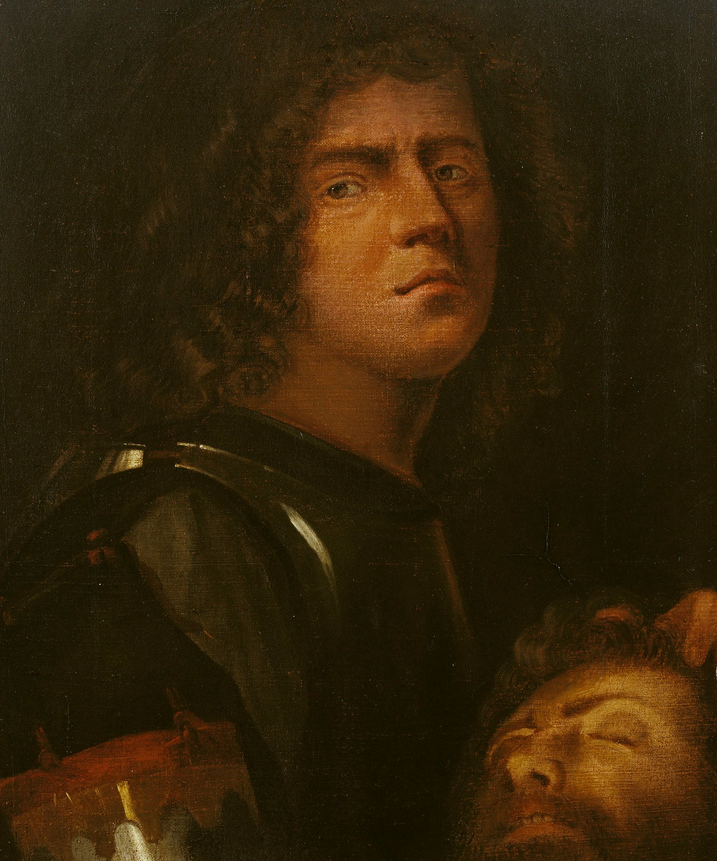
The Madonna drawing at the University of Sydney is in itself an important discovery for Australians, as it seems that no public art gallery in this country presently holds any original work by Giorgione. One of the nearest things we have here is a print from an etching that was made in the Netherlands in 1650 by Wenzel Hollar (after Vasari’s image of what is known as Giorgione’s Self-Portrait as David with the Head of Goliath — above) in the collection of the NGV at Melbourne, acquired through the Everard Studley Miller Bequest in 1959. The Fisher Library’s small drawing is thus also an important addition to his oeuvre.
For comparison’s sake, in regard to the history of unusual finds which have entered Australian public collections, one can note the following examples, which show the need for watchfulness by the curatorial staffs of galleries and libraries. The first is the wax relief The Flagellation of Christ by Giambologna (below) in the collection of the Queensland Art Gallery. The gift of the Queensland Museum in 1965, this wax earlier had been relegated to the museum’s basement staff room, hanging just above a darts board for many years, before being identified by an astute director and verified by international experts.[2]
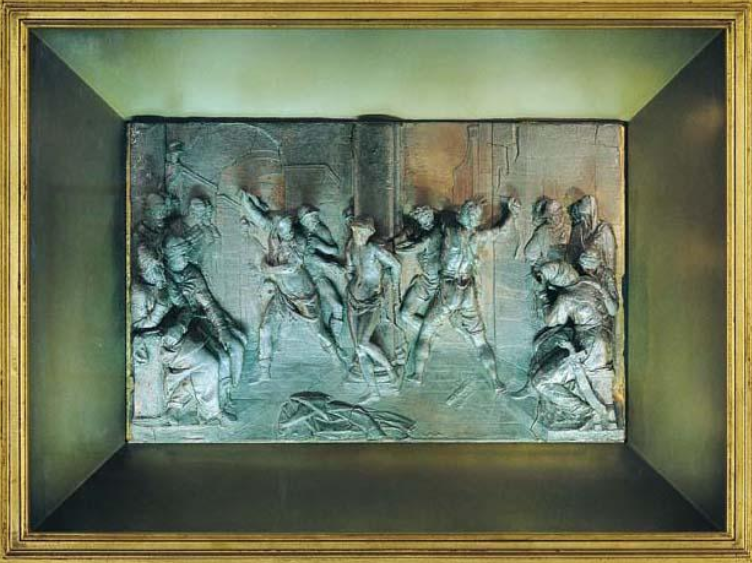
Another example was an early North Italian religious picture which turned up in Australia in 1882 “hidden in the false bottom of an abandoned packing case in Port Adelaide”.[3] That picture, accepted as one by the Master of the Uttenheim Altarpiece and depicting St Martin of Tours and St Nicholas of Bari (Tyrolese, circa 1470s) entered the collection of the Art Gallery of South Australia in 1943 (below). Hence, the 2017 Giorgione find in Sydney underlines the point that there is need for great caution by librarians, especially in these times of massive de-accessioning in libraries the world over, when many smaller minds blinded by the availability of the useful but by no means perfect resource of the internet, have used that as an easy excuse for their supposed “cost-cutting”. It also shows the importance of true art historical knowledge as well as the practical skills of discovering any concealed or overlooked items of significance.
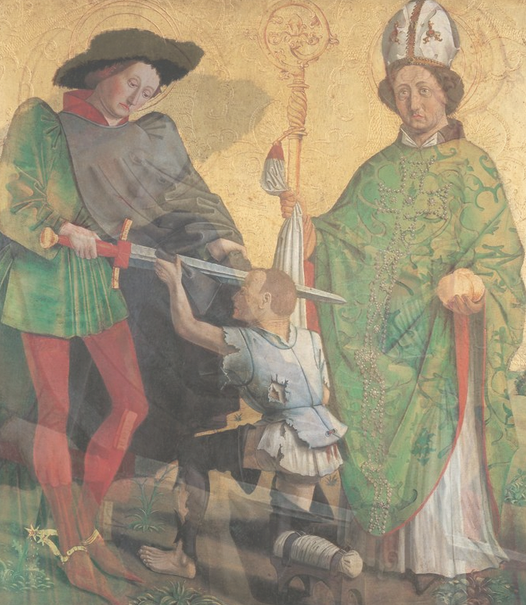
The literature on Giorgione is now considerable—which is a remarkable thing for one great painter about whom we have been left with extremely little secure information indeed. It is this in itself which makes the Fisher Library find of such signal importance for the scholarship on Giorgione of Castelfranco. It is not that the Sydney inscription and drawing alter greatly the conjectures as to Giorgione’s dates of birth and death, but rather that the inscription now provides more secure and exact evidence of the date of his death and also suggests that he was born around 1474. Scholars have already pointed out the special case that Giorgione presents, by virtue of the short span of his working career as an artist of only about fifteen years. The usual division of an artist’s output into youthful works, then others of mid-career, followed by late works, is thus less helpful in the case of Giorgione. This has long been one problem in studying him.
Hence the element of confirmation which the Sydney find brings to Giorgione’s lifespan and to the chronology of his works and development as an artist, is an assistance to scholars specialising in his and Venetian art generally.
A lengthy and distinguished roll-call of international art scholars and connoisseurs have given their opinions on Giorgione and his oeuvre over the past 200 years. They include Cavalcaselle (1871) who accepted only eighteen pictures as by Giorgione; Morelli (1880–91) who accepted nineteen pictures; Berenson (1894) and Adolfo Venturi (1900) who essentially followed Morelli’s attributions; Cook (1900) who accepted as many as forty-six pictures and wrote a broadside against the “restrictive” attributions of Cavalcaselle and Morelli; and Justi (1908) who, like Cook, had what Ludwig Baldass called an “excessive critical tolerance”. This provoked a reaction, as seen in Tancred Borenius (1912), “who went back to sixteen genuine pictures, and by Lionello Venturi, who accepted only thirteen”. After this came Hourticq’s study (1919) relating the works of Giorgione and Titian and then works by Suida (1933) and Morassi (1943) along similar lines. Richter’s study (1937) was what Baldass calls “a milestone in the critical understanding of Giorgione’s work”. Indeed, in that same year, a dispute over the major art dealer Lord Duveen seeking Bernard Berenson’s attribution of the Allendale Nativity to Giorgione caused a breach between those two titans of the world of dealing in and connoisseurship of Italian art. In later decades, some of the most significant of the studies which appeared on Giorgione included Baldass’s monograph with notes on plates by Gunther Heinz (1965), Terisio Pignatti’s Giorgione: Complete Works (1969) and Salvatore Setti’s book focusing upon La Tempesta: Giorgione’s Tempest: Interpreting the Hidden Subject (1990). The most severe scholars limit the number of definite Giorgiones to as few as six: others contend for further works, and up to twenty, thirty, or more, not to mention a body of works more or less securely “attributed” to Giorgione.
Carlo Ridolfi had as long ago as 1648 suggested that Giorgione was in fact born at Vedelago, a small town in the Veneto region, close to Castelfranco Veneto. This suggestion is still not yet proven, but it seems a possibility. When visiting Vedelago in 2015, I noticed that the local Comune there have certainly embraced Ridolfi’s conjecture and have named a street Via Giorgione. Ridolfi’s notion is at least interesting and it appears to be plausible, given the proximity of Vedelago to the larger Castelfranco Veneto. Incidentally, it is notable that quite near Vedelago is that distinguished villa by the architect Andrea Palladio, known as the Villa Emo, in the locality of Fanzolo, where the lively and distinguished frescoes executed by G.B. Zelotti are to be seen.
Most of us who have had the good fortune to see original oil works by Old Masters know the special delight to be had when the eye alights upon a genuine Titian picture. Something very similar, and perhaps even more engaging, happens on seeing one of Giorgione’s. Space here does not permit any lengthy disquisition on the complex issues of authentication on one hand and of attribution on the other, which apply to the much-debated field of Giorgione’s oeuvre. It must suffice to notice the effects produced upon careful observers by certain of Giorgione’s greatest works amongst the small company of those which are nowadays considered autograph by Giorgione.
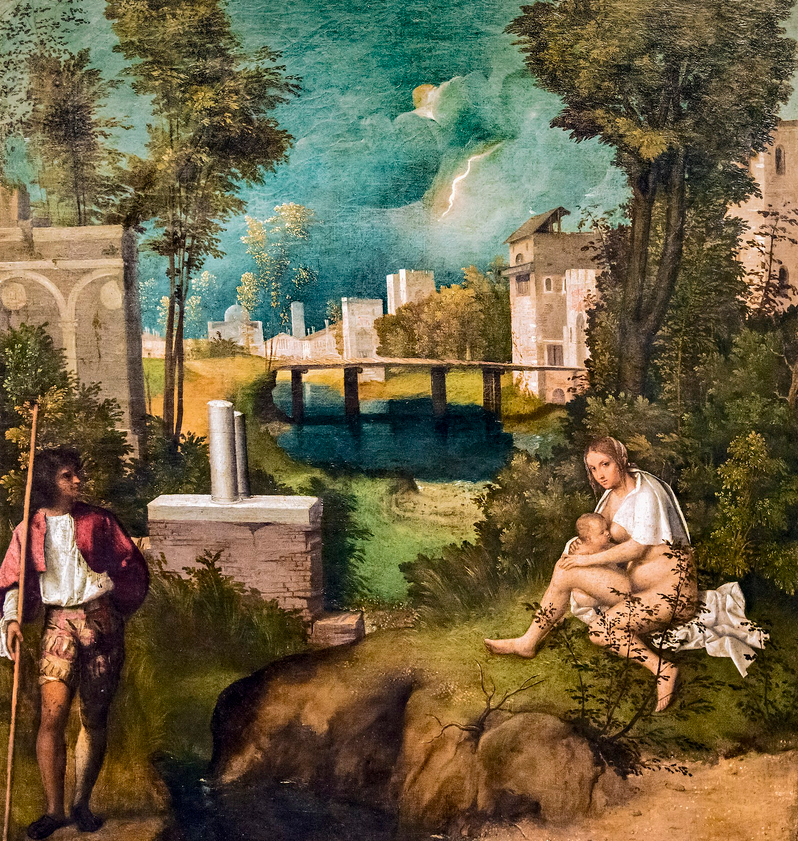
A good place to start is perhaps the most famous and notoriously difficult as far as its iconography goes: The Tempest (c.1508) in the Accademia at Venice (above). The distinguished travel writer Jan Morris (who in another life, first conveyed the news of the ascent of Mount Everest in 1953) has in autobiographical mode noted the special and moving effects of seeing this and other pictures by Giorgione. Morris’s passage is worth quoting in full, as it sums up what many feel, in words which fittingly go quite beyond the constraints of academic debates:
It took me time to learn to look at pictures … I chiefly liked pictures of places I knew, like preferring music whose tunes one knows. All this was changed for ever when long ago in Venice, I fell under the spell of Giorgione. One of the gifts of soldiering in Italy was the chance to see, as in a rough-and-ready Grand Tour, some of the greatest of paintings in their proper settings. I had already been introduced on their home ground to Leonardo, Botticelli and Titian. I had valued the experience, and still feel that in an ideal world all works of art would be returned to their countries of origin. But I felt no very profound response until I found myself standing in front of Giorgione’s La Tempesta. This peculiar masterpiece affected me most deeply. It was not merely its subject matter that fascinated me with its sense of permanently suspended enigma; I felt too, in a way I had never felt before, that I was in the actual presence of the artist. It seemed to me a haunted picture, around which Giorgione himself hovered wraith-like and tantalizing.
Since then I have seen almost every Giorgione in the world—almost every one, that is, listed with certainty in the Rizzoli catalogue, not to mention scores of pictures more dubiously attributed to him. From Leningrad to Washington, Oxford to Budapest I have pursued his enigmatic genius and I have strong feelings about the authenticity of paintings that hang above his name. I swear I can tell if a picture is really his—if he is present, that is, as he was on that revelatory day before La Tempesta, if I can sense his smoky concentration there, if I can glimpse his secret half-smile somewhere in the oils, or imagine his tap upon my shoulder. Few painters are less known as men than Giorgione, but I feel I am his intimate and whenever I see one of his intenser masterpieces a delicious satisfaction seizes me. It is as though, not to put too fine a point on it, through Giorgione I am in touch with God. This obsession has put a very different complexion upon my art appreciation.[4]
As much as experts may sniff at Morris’s comments, as if they were examples or proofs of the legend of the “Giorgionesque”, it seems to me that Morris is far from alone in treasuring the effects of a Giorgione picture. Accordingly, I am certain than many readers will have shared that experience. This is so even if The Tempest were now to be given to another than Giorgione.
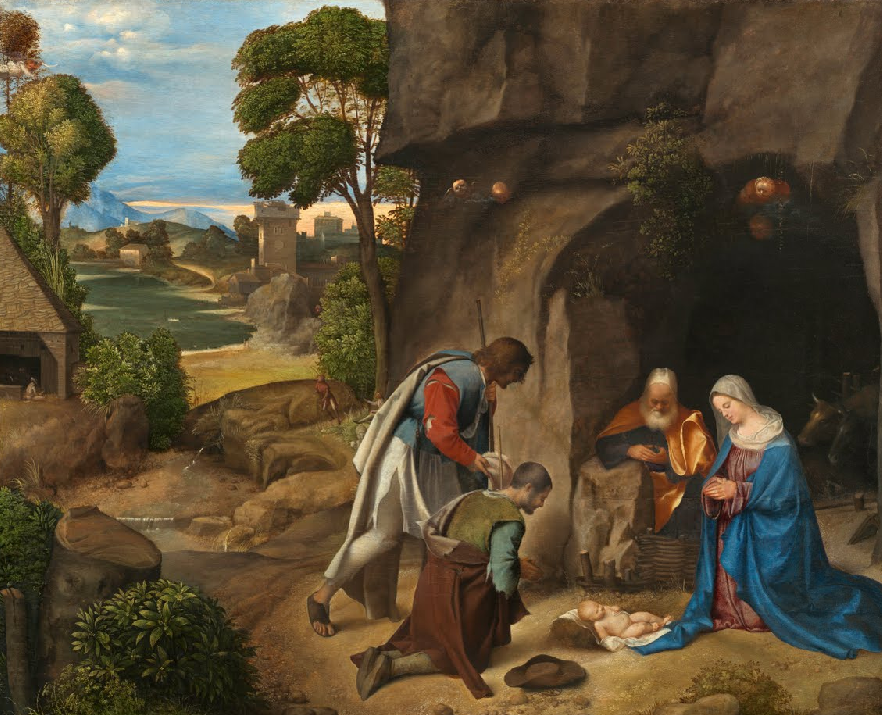
Giorgione’s Adoration of the Shepherds (above), now in the Kress Collection at the National Gallery in Washington DC, known as the “Allendale Nativity”, is one of the artist’s most widely admired paintings. Recently, it was the subject of Martin Gayford’s “By Giorgio” a delightful essay written for the Christmas 2021 issue of the Spectator, in which he noted the Sydney find. Gayford reminds us that “Giorgione and his works have often seemed the elusive essence of the Renaissance” and he describes the Allendale Nativity picture as “a masterpiece in which you can see religious awe combined with sensuous pleasure in the beauty of the world. In other words, it is truly, deeply, Christmassy.” He also notes that it may have been this particular Nativity picture to which Isabella d’Este, Marchioness of Mantua, was referring when on October 25, 1510, she wrote a letter to her Venice agent, urging inquiry and information: “We believe that in the effects and the estate of Zorzo da Castelfranco, the painter, there exists a painting of a night scene, very beautiful and unusual.” The reply came back to Isabella that her agent “had discovered two such paintings, both by Giorgione, but neither owner was ‘willing to sell at any price, for the reason that they wish to keep them for their own enjoyment’”.[5] Before the Sydney inscription find, it was believed from the text and context of Isabella’s letter that Giorgione had died during October 1510. It now seems certain he died in September, earlier than the letter suggests.
We have space to consider just five other major works which are more or less securely still given to Giorgione and which have delighted many generations.
The first is the Sleeping Venus (c.1510) in the collection of the Gemaldegalerie in Dresden, where the former Director was Ludwig Baldass, one of the twentieth century’s greatest authorities on Giorgione.[6] The second group is the luminous Boy with an Arrow (1506) in the Kunsthistorisches Museum at Vienna (below) and also the Shepherd with a Flute (c.1510) in the Royal Collection at Windsor Castle.

The third is the Col Tempo sometimes known as La Vecchia (c.1506) which is in the Accademia at Venice. The Dresden Sleeping Venus is one of the great masterpieces of European painting and one sees its major influence in any number of works on similar themes by later artists. It is a supremely beautiful and appealing picture. Sydney Freedberg has said this of it:
The shape … is the visual demonstration of a state of being in which idealized existence is suspended in immutable slow-breathing harmony. All the sensuality has been distilled off from this sensuous presence, and all incitement; Venus denotes not the act of love but the recollection of it. The perfect embodiment of Giorgione’s dream, she dreams his dream herself.
That picture must have been a continuous inspiration for Baldass, who devoted much of his life to the study of Giorgione. Despite ill-health he managed to complete his important monograph on the artist, with the help of Gunther Heinz, before his death in 1963. Next, the Boy with an Arrow at Vienna is likewise an immensely impressive and appealing work, which displays in high degree the subtle and insinuating art of Giorgione in the rendering of this pastoral visage, which some have thought rivals Leonardo’s Mona Lisa for the air of reserve and inner poise. It is a work which is now almost universally given to Giorgione. The Shepherd with a Flute in the Royal Collection at Windsor is now assigned by many scholars to Titian. Even so, it also shows much of the kind of sfumato treatment of which Giorgione was the great master. It featured as picture No. 1 in the important exhibition held at the Royal Academy of Arts in London in 1960, “Italian Paintings from British Collections”. As to the Col Tempo (“With Time”) at Venice, which depicts an old lady who had been once a great beauty, Sir Kenneth Clark remarked in his filmed series for television, Civilisation, upon its philosophic and telling qualities. It hangs in the Venice Accademia close to that enigma of a picture The Tempest and almost as a kind of pendant thereto.
The Altarpiece of the Madonna with Child and St Nicasius (or St George or St Liberale) and St Francis (c. 1504) in the Memorial Chapel of the Costanzo Family in the Duomo or Cathedral at Castelfranco Veneto, is the one work about which there is really no debate at all as to its being an authentic and autograph painting by Giorgione. It also seems to be a relatively early work. As one of his best-known pictures, it is frequently illustrated. Art history scholars regard it as a special case, due to certain unusual iconographical features. The Madonna is seated enthroned with the Christ Child, but looks down and slightly beyond, as if in contemplation also of the tomb of the young soldier in the chapel floor at the foot of the altar. Likewise, both the Armoured Knight and St Francis make subtle but poignant gestures also indicating the tomb below. The background landscape is richly rendered.
As seen in its chapel at Castelfranco Veneto in 2015, this altarpiece remains impressive in a quiet and commanding manner. This is an important work for the history of Renaissance art and it is to be seen in one place where, because of the location, it is usually possible to view and contemplate the picture without the press of the dense crowds in the major European galleries. This, if nothing else of Giorgione’s is possible on a tour, is well worth viewing.
It only remains to note also the much-debated case of the important and greatly celebrated painting known as the Fete Champetre (c. 1509) in the Louvre at Paris, which is now regarded by most of the leading Giorgione specialists as being either solely or primarily the work of Titian, but perhaps with certain elements done by Giorgione. Certainty is elusive, but overall we now have, thanks to recent discoveries including that in the Fisher Library at Sydney, further information about the life and works of Giorgione. Regardless of the debates on exactly how many authentic Giorgione pictures there are, it remains clear that his use of ardent colours and subtle gradations of light and shade, conferred a distinctive quality on Venetian art. It is also quite clear that he also influenced European art generally. Over recent years, we have been fortunate that some oils attributed to Giorgione have been shown in Australia in major travelling exhibitions. One memorable picture was the Double Portrait from the Palazzo Venezia Museum in Rome.
If and when the Covid blight upon the whole world is ever lifted, and provided no new and worse thing arrives, we might all hope to see again some originals of Giorgione’s rare and moving works in oils. Meanwhile, we have in Australia the small drawing by Giorgione in that 1497 edition of Dante’s Divina Commedia in the Fisher Library, whose curators and associated staff deserve great credit for making their find. If the price of freedom is eternal vigilance, the price of our heritage is likewise a matter of watchfulness to ensure that small but important things are not overlooked and allowed to pass into the darkness of oblivion. Indeed, during the Second World War, Professor Pasquale Rotondi, Central Inspector for the Fine Arts in September 1943 at the time of the Armistice of Cassibile, took the wise precaution of concealing Giorgione’s La Tempesta under his bed in order to prevent it falling into the hands of Hitler’s art-looting Nazi agents in their ensuing staged retreat from the Italian peninsula.
Dr Douglas Hassall, who lives in Melbourne, is a frequent contributor on the arts
[1] On Griffith, Dante and Italy, see especially: Joyce RB Samuel Walker Griffith UQP 1984 passim; Schultz K “Griffith the Dantista” Sir Harry Gibbs Legal Heritage Centre, Supreme Court of Queensland Library Exhibition Paper; Pannam C “Dante and the Chief Justice” 1959 Vol 33 Australian Law Journal page 290.
[2] Mellish R “Queensland Art Gallery; Selected Works” Brisbane 1982 at page 14
[3] Trumble A “Recent Loans from Adelaide to Italian Art Museums” in “The World of Antiques & Art” 2000; see Baily J Picture Book: Selected Works from the Art Gallery of South Australia AGSA Board 1972 page 7.
[4] Morris J Pleasures of a Tangled Life Arrow Books London 1990 pages 170-171
[5] Gayford M “By Giorgio” in The Spectator 18 December 2021
[6] See Baldass L with Heinz G Giorgione Thames & Hudson London 1965.
 Sign In
Sign In 0 Items (
0 Items ( Search
Search










Thank you for this quiet and pleasant reading and for the accompanying pictures. Art allows us to feel we can touch and place ourselves within the past, to see those living then in the imagination of their times.
Finding rare items that can help us to situate a master artist (and those who may have worked in a similar manner) also creates for us a material connection with things long gone – the finding of some forgotten piece or addendum in an ancient book. What a special joy that would be. I have a few collected old books, the look and feel and content of which allows a few moments of reflection in a dedicated chair away from the pressures of today. I imagine those people who may have held and read them before me. A day spent in a library carefully searching for old mementos in old books would not be a day wasted.